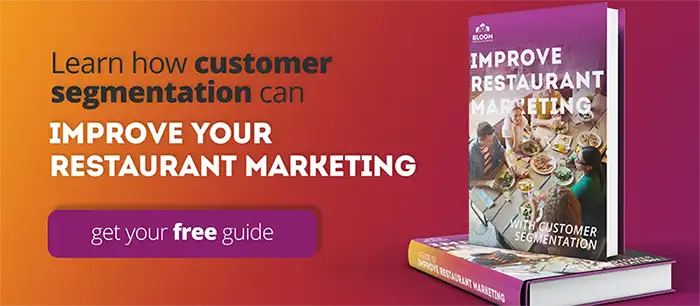Restaurant marketers are intrigued by behavioral segmentation concepts used by digital businesses and larger companies. Still, they are also frustrated that those market concepts have been mostly inaccessible because of brick and mortar customer tracking limitations.
For instance, restaurant marketers are frustrated because they cannot leverage behavioral segmentation in their marketing. However, with tools like Wi-Fi marketing platforms, marketing based on market segmentation is now possible for companies with brick and mortar businesses.
What Is Behavioral & Psychographic Segmentation for Restaurants?
Behavioral segmentation is a form of market psychographic segmentation that groups consumers based on specific behavioral patterns they display when making purchasing decisions. Behavioral segmentation for restaurants drives marketing strategy because it allows marketers to target specific groups based on actual consumer buying behavior.
The psychographic behaviors most often tracked for customer segmentation purposes are:
- Knowledge of the product
- Attitude towards the product
- How, when, and how often the customer uses the product
- Customer loyalty to the product
- The benefits sought concerning the product
Digital businesses leverage behavioral segmentation in their marketing and product development in myriad ways.
See How You Can Segment Your Customer Behavior Using Bloom Intelligence
For example, the company may look at where their customers come from – Google search, Facebook, a referral link, another online avenue – and what products they view or buy. Based on this information, the business can decide which channel might be the best for advertising certain products to a correctly identified market segment.
How Behavioral Market Segmentation Can Benefit Restaurants
Brick-and-mortar businesses, including restaurants, can also realize advantages by incorporating behavioral segmentation into their marketing and operational strategies.
- Dietary Preferences. If you seek to market new menu items or even develop new menus, knowing your client’s “use” behavior is very useful. If you have many customers who want gluten-free options, include a “GF” symbol by each item to market those items to those customers. Or, if you see a growing base of health-conscious customers, devote a section of the menu to superfood-packed meals. Getting this information is as easy as offering a quick survey (online or tableside), email address required, in exchange for a chance to win a free meal, discount, etc. With the survey data and email addresses, you can also market to relevant segments through email campaigns!
- Take Out Orders. How your customers consume your food – as dine-in or take-out guests – is another essential customer segmentation. If you know that more customers are ordering take-out each month, you might want to consider adding a small Grab & Go section for your location. If you operate a fast-casual or quick-service restaurant, you might consider separating your production line for dine-in versus take-out guests.
For Children:
- Kid-Friendly Meals. If you have a fast-casual restaurant, you can divide your benefits-based customer segments as follows: family treat (they choose your product as a reward for the family); taste preference (liking your food); convenience (choosing your restaurant because it’s an easy option at the time); pressed for time (being there simply because it’s the fastest option and they are rushing around); real meal (perceiving your restaurant as giving them an opportunity for a whole or even healthy meal); or, a meeting place (finding your restaurant suitable for meeting with others, and will grab a bite while there).
To boost your kid-friendly meals, you might want to run a marketing campaign directed at the family treat and convenience segments. Understanding these segments’ motivations can drive the campaign by focusing the ads on your clean, friendly, and fun environment, comfortable to eat food, fast service, and the excellent value of the food.
Understanding Customer Behavior
To incorporate behavioral segmentation into restaurant marketing, marketers need to understand their customer’s behavior. They need a way to track customer purchasing behavior, visiting behavior, and preferences related to their products and their industry. For some generalized information, reviewing yearly reports from the National Restaurant Association can help you start. Many other websites and videos are available to help restaurateurs understand their market segments better.
- Forbes | Restaurant Segments Going Under (2013) & Better Data Enables Better Customer Segmentation (2015)
- YouTube | Market Segmentation Introduction (2015) & Behavioral & Psychographic Segmentation (2016)
- Other Online Resources | Market Segmentation “Study Guide” For Marketing Students & Restaurant Industry Blog on Market Segmentation
But above all, you need location-derived data. In-house surveys, customer loyalty metrics, loyalty program participation, and daily restaurant traffic should be measured and analyzed. Concerning the take-out example used above, you may not have a POS system that distinguishes between take-out and dine-in orders. So, you need another tool to help you track that data. Likewise, you want a tool that can help you grab customer email addresses, ultimately linked to visiting and purchasing behavior and customer loyalty. You can roll out ads and promotions directed to the appropriate consumer segments.
Compelling Market Segmentation Statistics for Restaurants
- Forbes reports that millennials spend 44% of their money on food.
- Millennials spend $163 per month going out to eat, while only 6% of millennials do not eat out month-to-month.
- People in the 35-44 age group spend more on food away from home.
- Although younger households pay less at restaurants, it represents a larger share of their total expenditures.
- Consumer spending at restaurants is generally higher in more densely populated areas.
It All Boils Down to Reliable Analytics Data
Ultimately, it would help if you had a solid baseline of useful customer analytics data to benefit from behavioral segmentation. A state-of-the-art data tool, such as a Wi-Fi marketing platform, can help capture this data. Distinguish the guests that dine at your restaurant from those who pick up a take-out order, all without a new POS system.









.svg)